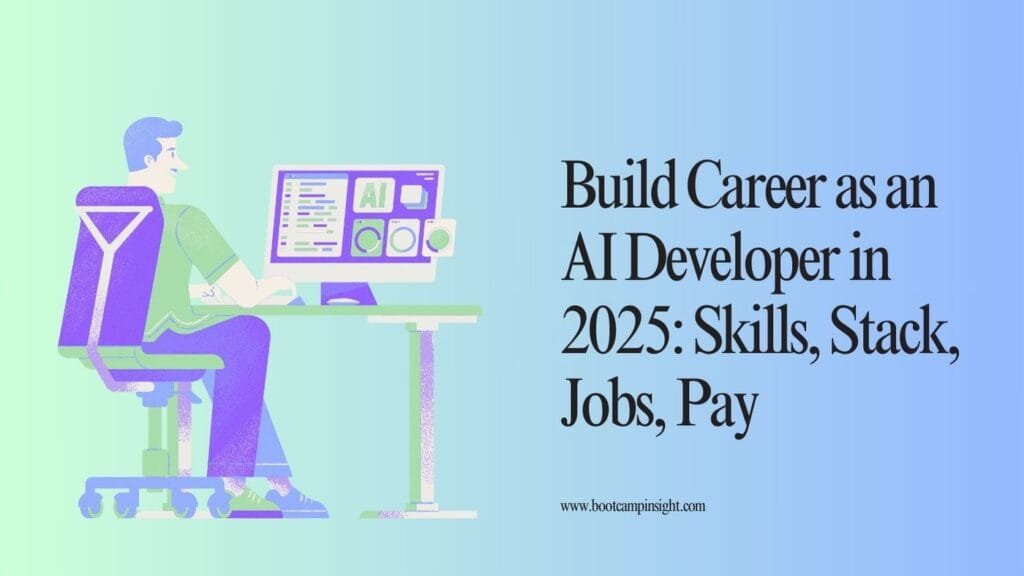why pursue an AI developer career in 2025
AI touches every product area. Adoption moved from pilots to production in many firms. Python climbed to the top language on GitHub, pushed by AI work. Demand spans startups and large enterprises. This guide gives a clear path. You get a skills map, a tool stack, a learning plan, and a job search playbook. McKinsey reports regular gen AI use across 65 percent of organizations in early 2024. GitHub’s Octoverse highlights Python’s rise linked to AI momentum.
The AI developer role and market demand
Teams hire for several titles. AI engineer, ML engineer, applied scientist, LLM engineer, and AI platform engineer. Daily work spans data prep, model training, evaluation, serving, and monitoring. Product work adds prompt design, safety checks, and UX integration. Demand signals look strong. LinkedIn’s 2025 list ranks AI engineer first among fastest growing roles in the United States. Broader software roles remain strong as well. BLS projects 17 percent growth from 2023 to 2033 and 140,100 openings per year for software developers, QA analysts, and testers. Firms expect skill gaps to slow transformation, which raises the premium for skilled hires.
Skills map: what employers expect
Start with software engineering. Write clean Python. Use tests. Profile code. Learn packaging. Ship small services behind clear APIs. Strength in Git, pull requests, and reviews signals readiness for teams.
Add math for ML. Focus on linear algebra, probability, statistics, and optimization. Know gradient descent, regularization, and cross validation.
Build core ML skills with scikit-learn. Learn data pipelines, feature engineering, model selection, and evaluation.
Move to deep learning. Pick PyTorch or TensorFlow and go deep. Train small CNNs and transformers. Learn scheduling, mixed precision, and debugging.
Add gen AI skills. Manage prompts. Build RAG systems with a vector database. Fine tune with LoRA or QLoRA. Evaluate with rubric scores and golden sets. Monitor for toxicity and leakage.
Adoption of AI tools inside the development workflow keeps rising. In 2024, 76 percent of respondents used or planned to use AI tools, up from 70 percent in 2023.
The modern AI stack and tools
Libraries and frameworks. Use scikit-learn for baselines. Pick PyTorch or TensorFlow for deep learning. Manage experiments with MLflow or W&B.
Data and training. Store datasets in object storage. Version with DVC. Use Ray or Spark for scale. Track metrics and artifacts for each run.
LLM and RAG. Use Hugging Face Transformers. Wire LangChain or LlamaIndex for orchestration. Store embeddings in Pinecone, Milvus, or FAISS. Cache responses for speed and cost control.
Serving and monitoring. Export to ONNX where possible. Serve with Triton, TorchServe, or TF Serving. Add Prometheus metrics and OpenTelemetry traces. Alert on drift, latency, and cost per request.
Python’s momentum across the stack matches trends in the GitHub Octoverse analysis.
Learning paths that work
Three routes deliver results:
- Degree route. CS or EE with ML focus suits research and platform tracks.
- Certificate route. Short programs and nano-degrees work with a strong portfolio.
- Self-directed route. A structured plan plus projects and community support.
Employers point to skills gaps as the top barrier to transformation, cited by 63 percent of respondents in WEF’s 2025 report. A focused learning plan with measurable outcomes addresses this risk for hiring managers.
Portfolio projects that prove skill
Build four projects that show range and depth.
- Foundational project. A tabular ML model for a real dataset. Include feature engineering, cross validation, SHAP plots, and an API that returns predictions.
- GenAI and RAG project. A knowledge assistant for an internal document set. Include retrieval, prompt templates, function calls, and a judge model for evaluation.
- Production-grade project. A small model served on Kubernetes with autoscaling, logging, and tracing. Include load tests and a rollback plan.
Domain project. Pick a vertical like healthcare, finance, or retail. Show business impact with a metric, for example hours saved or error reduction. - Regular gen AI use inside firms supports portfolios that highlight LLM features and safe operation.
Shipping to production with MLOps
Production changes expectations. Reproducibility first. Pin environments. Version datasets and models. Record seeds and configs.Build pipelines. Use a workflow tool like Airflow or Prefect for training and batch scoring. Register models with MLflow. Gate promotion with automated tests and offline evaluations.
CI/CD for models. Add unit tests, data tests, and fairness checks. Set canary deploys for new models. Roll back on drift, latency spikes, or metric drops.
Cost and reliability. Track cost per thousand requests for LLM features. Cache aggressively. Use quantization where quality holds. Job postings show consistent demand for Python and SQL across AI roles, which underscores the need for robust engineering around models.
Ethics, safety, and compliance
Responsible AI is part of the job. Start with the NIST AI Risk Management Framework. Use the Generative AI Profile for control ideas specific to LLMs. Build threat models for prompt injection, data leakage, and unsafe outputs. Add red teaming, guardrails, and human review where risk requires. NIST released the GAI Profile in July 2024 to guide risk management.
Job search and personal brand
- Treat job search as a product. Define a target role and a target stack. Pick five companies per week.
- Resume should be One page. Quantified results. Show repos, demos, and metrics.
- GitHub. Pin four flagship projects. Add READMEs with setup, tests, and demo links.
- LinkedIn. Summarize skills and projects with outcomes. Post short updates on builds and lessons.
- Networking. Join communities. Ask for small favors, for example feedback on a repo.
AI roles lead growth lists in 2025, so tailored outreach plus a strong public portfolio raises response rates.
Interviews and salary negotiation
Prepare for three areas.
- Coding. Solve tasks in Python with tests. Focus on data structures that match ML workloads.
- Modeling. Explain tradeoffs, baselines, and evaluation. Walk through feature choices and error analysis.
- System design. Design an inference service with load, latency, monitoring, and rollout plans.
After an offer, reference market data. Median ML engineer total compensation sits near 249,330 dollars in the U.S., with wide variance by level and region. Jobs listing AI skills offer a 28 percent salary premium on average. Come ready with asks on base, equity, and learning budget.
FAQ
Start with linear algebra basics, probability, and calculus for optimization. Add depth over time.
End-to-end builds with tests, docs, and a live demo. Include a clear metric and a short write-up.
Six to twelve months with a weekly routine and consistent output.
Pick one. PyTorch or TensorFlow. Reach comfort with training loops, debugging, and exporting for serving.
Learn one cloud. Ship a small model behind an API with logging and monitoring.
Expect a broad range near 200k to 300k total compensation, shaped by level, region, and company size. Use fresh data during negotiation.
Closing thoughts
AI development rewards builders who learn fast and ship. Follow the skills map. Build a focused portfolio. Treat job search as a product. Use standards for safety. Keep learning. Strong demand and strong fundamentals meet in this field. The next step starts with one small project today.



